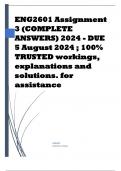Exam (elaborations)
ENG2601 Assignment 3 (COMPLETE ANSWERS) 2024 - DUE 5 August 2024 ; 100% TRUSTED workings, explanations and solutions.
- Institution
- University Of South Africa
- Book
- Working with Texts
ENG2601 Assignment 3 (COMPLETE ANSWERS) 2024 - DUE 5 August 2024 ; 100% TRUSTED workings, explanations and solutions.
[Show more]



